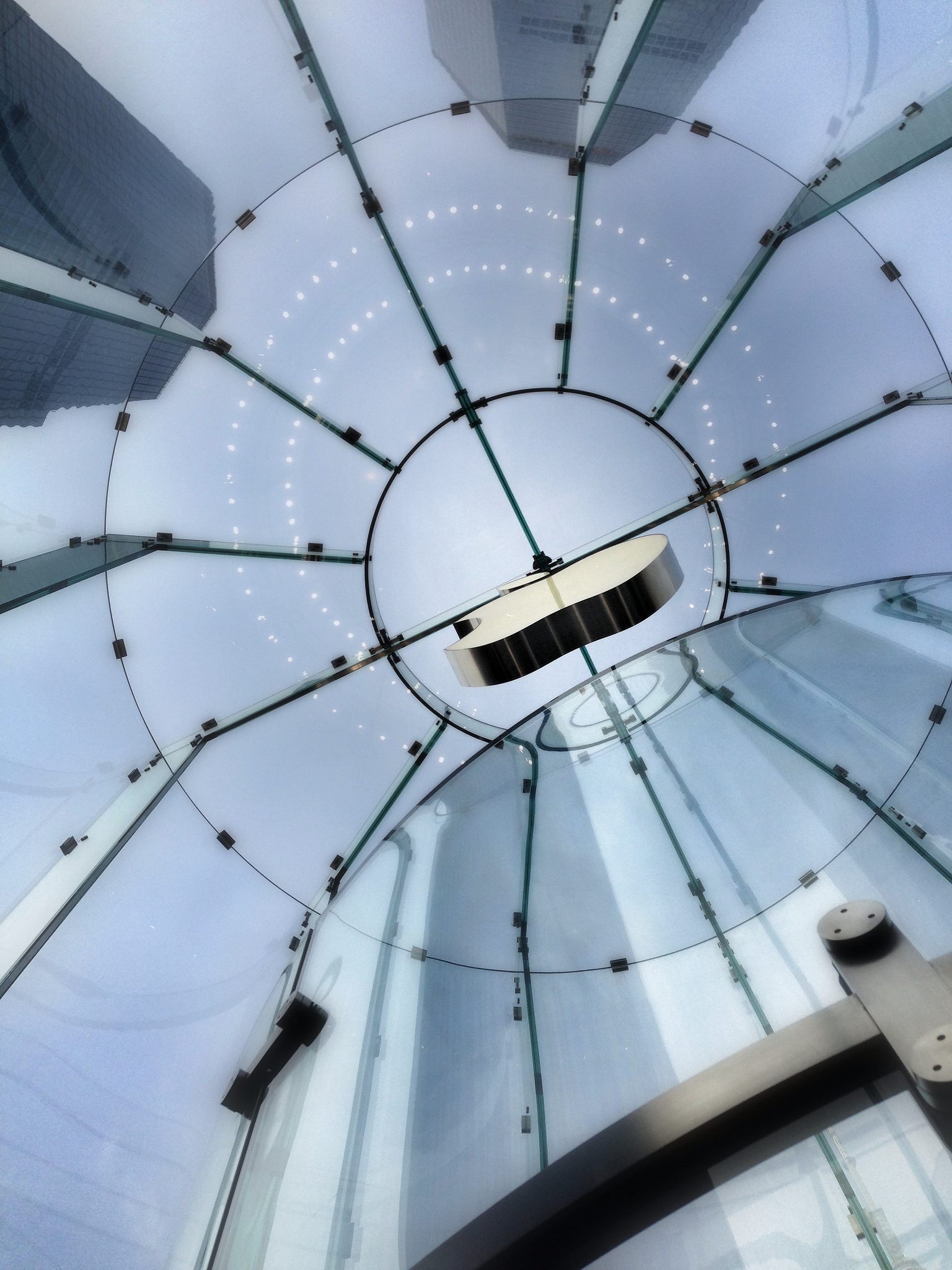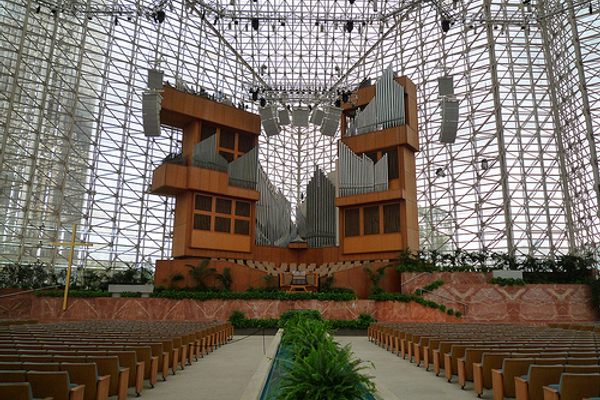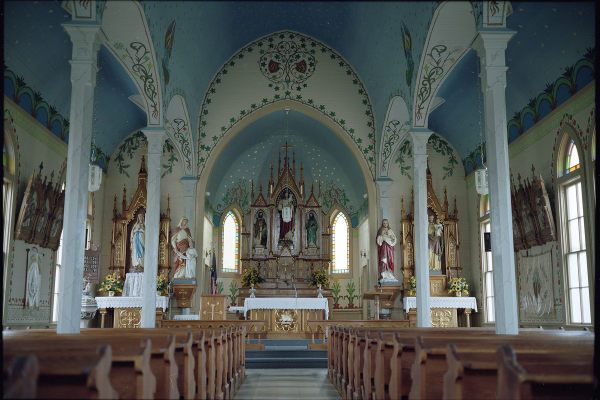We Asked a Cultural Historian: Are Apple Stores the New Temples?

The Broadway Apple Store (Photo: Matt Buchanan/Flickr)
In more ancient times, when communal experiences were mediated by religion, crowds used to gather outside temples on feast days. In Biblical times, for instance, on pilgrimage holidays like Passover, Jewish people were supposed to travel to Jerusalem, to be present at the Holy Temple, where the High Priest would make a sacrifice to God.
Nowadays, we have Apple Release Day—the Feast of St. Jobs—when faithful customers gather outside Apple stores and await the renewal of a next generation iPhone.
But is the Apple store really like a sacred space? To find out, Atlas Obscura brought a cultural historian to a Manhattan location for some feedback.
One of the first lessons from Erica Robles-Anderson, a professor at New York University, is that the collective experience of an Apple release does not come about by chance. Not far from the Apple Store in SoHo, one of New York’s high-end shopping districts, a Samsung store opened recently. “They had giant ropes outside, as if anticipating a giant crowd, and big bouncer-looking people in fancy suits,” she says. “And then…crickets.”
The problem wasn’t just a lack of PR. “It was a deep misunderstanding about special access, as opposed to what Apple has built, which is the feeling of being in it together, as though you were fighting something,” Robles-Anderson says, “even though it’s the most valuable company in the world.”
Robles-Anderson studies the role of media technology in the production of public space. Recently, her work has focused on churches, and how they’ve used technology to enhance collective space. “We forget that cathedrals were basically high end technology,” she says. So were Stonehenge and the Buddhas carved into mountains. More recently, the first indoor installation of a Jumbo-tron was at California’s Crystal Church, one object of her study. “People have used technology for a long time to speak to the gods,” she says—to create collective experiences of the sublime.
These days, technology is more often talked about as a way to create personalized, individual experiences, but Robles-Anderson thinks that’s only part of the story. Communal ritual is always a part of technology: Early computers came into group spaces, like families and offices. (Mad Men understood this dynamic: the computer as an event weathered together.) Powerpoint presentations gather people to look at giant screens. Even using an iPhone to tune out the human beings around you requires being part of a larger group.
And Apple, more than any other technology company, has been able to access both these experiences, the individual and the collective. “They feel iconic, like an emblem of the personal,” says Robles-Anderson. “And yet it’s a cult. Right? It’s so obviously a cult.”

An Apple store in Paris (Photo: Mikhail (Vokabre) Shcherbakov/Wikimedia)
On our way to the SoHo Apple store, just around noon, we pass the beginnings of a line, forming in anticipation of the release of the iPhone 6s. Within the next twenty hours, before Apple employees begin selling phones, at 8 a.m., it will extend down the block, around the corner and on down the street.
It’s kept, though, neatly out of sight from the gates of the Apple store. This one was built in a former post office, another collective space, which, Robles-Anderson points out, enabled the packaging and transit of information. The old designation, STATION A, is carved in stone above the giant doors, edged in black.
“The oversized doors are fantastic,” says Robles-Anderson. “There’s no reason for them.” They’re there only to communicate that this place is important. Also, they’re heavy, like church doors, to give purpose and portent to the entry into the space.
We walk inside. It’s light and bright, and immediately in front of us, a wide staircase of opaque glass sweeps up to the second floor.
This is an old, old trick. “It’s used in ziggurats, even,” Robles-Anderson says. “It creates a space that emphasizes your smallness when you walk in. You look at something far away, and that makes your body feel like you’re entering somewhere sacred or holy.”
To enter that sacred space, first we have to walk up a few stone steps. They’re wide and deep, enough that you have to slow down just a bit to walk up them. Steep and narrow steps create the same effect in that they make your body feel as if something important is happening. Above, a massive skylight, stretching the length of the room, lets in the light. To the right and left are the tables with phones and watches arranged around the periphery—a clue that this is not supposed to be an individual experience. Even when you are holding the phone in your hand, you are gathered around a table with others. There are no aisles here to sequester yourself in: thanks to the open floor plan, you experience the phone together with everyone in the store.
“They have this beautiful, excessive use of clear surfaces,” Robles-Anderson says. “You’re always seeing others and being seen by others. And the ways that any employee can serve you feels personal, but it’s going on all around you, in a cacophony of like-mindedness.”
We ascend. To reach the second floor, we must pass under a walkway that crosses the entry’s vertical expanse. This is another strategy borrowed from holy spaces. “You slightly drop the ceiling, so that when you come out underneath it, you have the feeling of the sublime and this massive expanse opens that feels awesome, literally—psychologically and in your body,” Robles-Anderson explains. And as we walk under the walkway and up the stairs, without even thinking about it, I look up and straight into the sky.

The SoHo Apple store (Photo: Sarah Laskow)
The second floor has a different purpose than the first. This is the place where Apple’s equivalent of priests—the Geniuses—impart knowledge. Immediately in front of us is a giant screen and a few rows of plush chairs. In contrast to the open room below, it’s dark, inviting, and intimate. This darkness is necessary to create the effect downstairs, too, a contrast to the sweeping space and the light. A Genius is on the platform, demonstrating an esoteric piece of Apple lore, a multiple-step undo. “It also reminds you of Steve Jobs on the stage,” says Robles-Anderson.
Any individual Apple store has to take on this task, reminding its local congregation that they are part of an even larger community, centered on Cupertino and, ultimately, Jobs’ vision. Although other stores take different forms, shaped to the buildings that they inhabits, these tropes carry through. On 14th Street, a three-story store in a old warehouse, a see-through spiral stairway right at the entrance pulls you upwards, bathed in light. On Broadway, just north of Columbus Circle, walls and ceilings of glass enclose a cathedral-like space, backed by a beige stone wall, in which the quiet talk of customers is amplified into the noise of a crowd; downstairs, the Genius bar is kept quieter, darker, but when you walk back up that same opaque, spiral staircase, it’s like floating upwards towards a more heavenly realm.

An Apple Store in Shanghai (Photo: Jon Skilling/Flickr)
“There’s more and more evidence that we’ve never stopped worrying about cosmological questions or communities,” says Robles-Anderson. “Technology is part of the fantasy that we’ve progressed away from those kind of explanations.” But in her ideal world, medievalists who think about God’s omnipresence, his connection to certain physical objects, and the meaning of that material culture, would be hired by cloud storage companies. “They’re dealing with the exact same problems,” she says. “Are you files really on your personal device or are they in the cloud in the sky?”
Apple seems to understand that the people who visit their store are looking for answering to questions deeper than how they should make calls or connect to the internet. On the walls of the stores, framed by the border of a screen, are pictures of planets and star systems—with these flat, luminescent, monolithic devices, they seem to promise, you can understand the entire universe.
















Follow us on Twitter to get the latest on the world's hidden wonders.
Like us on Facebook to get the latest on the world's hidden wonders.
Follow us on Twitter Like us on Facebook